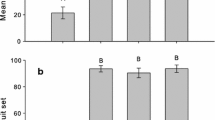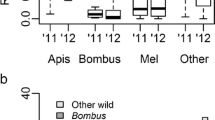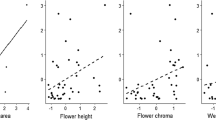Abstract
In plant species that are pollinated by a variety of animal species, spatial and temporal variability in the taxonomic composition of those pollinators may cause spatial and temporal variability in selection on floral traits. While temporal variation in pollinator composition has been widely reported, spatial variability, particularly on a local scale, has been studied less frequently; nevertheless, available evidence suggests that local spatial variability may be a widespread feature of plant-pollinator interactions. In addition, the causes of this spatial variability are poorly known. This study was undertaken to quantify variability in the taxonomic composition of pollinators visiting local populations of black mustard, Brassica nigra, and to determine some of the causes of this variability. Simultaneous observations were conducted in seven pairs of black mustard populations. The members of each pair were in close spatial proximity but differed in number of plants. Larger plant populations were visited by significantly greater numbers of honey bees and significantly fewer small bees than small populations on a per-plant basis. There was also a trend toward greater syrphid fly visitation in small populations. The increased numbers of honey bees at large plant populations is probably due to their ability to recruit long distances to the most rewarding plant populations. The lower number of small bees at large plant populations may be due to competition from honey bees and/or spreading a constant number of small bees over the larger number of plants in large populations.
Similar content being viewed by others
References
Abelbeck Software (1993) KaleidaGraph, version 3.0. Synergy Software, Reading, Pa
Aizen MA, Feinsinger P (1994) Habitat fragmentation, native insect pollinators, and feral honey bees in Argentine “Chaco Serrano”. Ecol Appl 4: 378–392
Ashman T-L, Stanton M (1991) Seasonal visitation in pollination dynamics of sexually dimorphic Sidalcea oregana ssp. Spicata (Malvaceae). Ecology 72: 993–1003
Campbell DR (1989) Measurements of selection in a hermaphroditic plant: variation in male and female pollination success. Evolution 43: 318–334
Cane JH, Payne JA (1993) Regional, annual, and seasonal variation in pollinator guilds: intrinsic traits of bees (Hymenoptera: Apoidea) underlie their patterns of abundance at Vaccinium ashei (Ericaceae). Ann Entomol Soc Am 86: 577–588
Chambers JM, Cleveland WS, Kleiner B, Tukey PA (1983) Graphical methods for data analysis. Duxbury Press, Boston
Darwin C (1877) The various contrivances by which orchids are fertilised by insects, 2nd edn. The University of Chicago Press, Chicago
Eckhart VM (1991) The effects of floral display on pollinator visitation vary among populations of Phacelia linearis (Hydrophyllaceae). Evol Ecol 5:370–384
Eckhart VM (1992) Spatio-temporal variation in abundance and variation in foraging behavior of the pollinators of gynodioecious Phacelia linearis (Hydrophyllaceae). Oikos 64:573–586
Feinsinger P (1983) Coevolution and pollination. In: Futuyma DJ, Slatkin M (eds) Coevolution. Sinauer, Sunderland, Mass, pp 282–310
Feinsinger P, Wolfe JA, Swarm LA (1982) Island ecology: reduced hummingbird diversity and the pollination biology of plants, Trinidad and Tobago, West Indies. Ecology 63:494–506
Galen C (1989) Measuring pollinator-mediated selection on morphometric traits: bumblebees and the alpine sky pilot, Polemonium viscosum. Evolution 43:882–890
Galen C, Zimmer KA, Newport ME (1987) Pollination in floral scent morphs of Polemonium viscosum: a mechanism for disruptive selection on flower size. Evolution 41:599–606
Harris RJ (1985) A primer of multivariate statistics, 2nd edn. Academic Press, New York
Herrera CM (1988) Variation in mutualisms: the spatio-temporal mosaic of a pollinator assemblage. Biol J Linn Soc 35:95–125
Herrera CM (1989) Pollinator abundance, morphology, and flower visitation rate: analysis of the “quantity” component in a plantpollinator system. Oecologia 80:241–248
Horvitz CC, Schemske DW (1990) Spatiotemporal variation in insect mutualists of a neotropical herb. Ecology 71:1085–1097
Jennersten O, Nilsson SG (1993) Insect flower visitation frequency and seed production in relation to patch size of Viscaria vulgaris (Caryophyllaceae). Oikos 68:283–292
Johnson LK, Hubbell SP (1974) Aggression and competition among stingless bees: field studies. Ecology 55:120–127
Johnson LK, Hubbell SP (1975) Contrasting foraging strategies and coexistence of two bee species on a single resource. Ecology 56:1398–1406
Klinkhamer PGL, Jong TJ de, Bruyn G-J de (1989) Plant size and pollinator visitation in Cynoglossum officinale. Oikos 54:201–204
Lindsey AH (1984) Reproductive biology of Apiaceae. I. Floral visitors to Thaspium and Zizia and their importance in pollination. Am J Bot 71:375–387
Morse DH (1982) Behavior and ecology of bumble bees. In: Hermann HR (eds) Social Insects, vol III. Academic Press, New York, pp 245–322
Neter J, Wasserman W, Kutner MH (1985) Applied linear statistical models, 2nd edn. Irwin, Homewood, Ill
Paige KN, Whitham TG (1985) Individual and population shifts in flower color by Scarlet Gilia: a mechanism for pollinator tracking. Science 227:315–317
Rice WR (1989) Analyzing tables of statistical tests. Evolution 43:223–225
Roubik DW (1978) Competitive interactions between neotropical pollinators and Africanized honey bees. Science 201:1030–1032
Roubik DW (1980) Foraging behavior of competing Africanized honeybees and stingless bees. Ecology 61:836–845
Roubik DW (1989) Ecology and natural history of tropical bees. Cambridge University Press, Cambridge, UK
SAS Institute Inc (1985) SAS users guide: statistics. SAS Institute Inc, Cary, NC
SAS Institute Inc (1994) JMP, version 3. SAS Institute Inc, Cary, NC
Schaffer WM, Jensen DB, Hobbs DE, Gurevitch J, Todd JR, Schaffer MV (1979) Competition, foraging energetics, and the cost of sociality in three species of bees. Ecology 60:976–987
Schemske DW, Horvitz CC (1989) Temporal variation in selection on a floral character. Evolution 43:461–465
Seeley TD (1985) Honeybee ecology: a study of adaptation in social life. Princeton University Press, Princeton
Seeley TD (1989) The honey bee colony as a superorganism. Am Sci 77:546–553
Sih A, Baltus M-S (1987) Patch size, pollinator behavior, and pollinator limitation in catnip. Ecology 68:1679–1690
Sowig P (1989) Effects of flowering plant's patch size on species composition of pollinator communities, foraging strategies, and resource partitioning in bumblebees (Hymenoptera: Apidae). Oecologia 78:550–558
Spears EE Jr (1987) Island and mainland pollination ecology of Centrosema virginianum and Opuntia stricta. J Ecol 75:351–362
Stanton ML (1987) Reproductive biology of petal color variants in wild populations of Raphanus sativus: I. Pollinator response to color morphs. Am J Bot 74:178–187
Stanton ML, Young HJ, Ellstrand NC, Clegg JM (1991) Consequences of floral variation for male and female reproduction in experimental populations of wild radish, Raphanus sativus L. Evolution 45:268–280
Thomson JD (1981) Spatial and temporal components of resource assessment by flower-feeding insects. J Anim Ecol 50:49–59
Wolfe LM, Barrett SCH (1988) Temporal changes in the pollinator fauna of tristylous Pontederia cordata, an aquatic plant. Can J Zool 66:1421–1424
Author information
Authors and Affiliations
Additional information
This paper is dedicated to the memory of George Eickwort
Rights and permissions
About this article
Cite this article
Conner, J.K., Neumeier, R. Effects of black mustard population size on the taxonomic composition of pollinators. Oecologia 104, 218–224 (1995). https://doi.org/10.1007/BF00328586
Received:
Accepted:
Issue Date:
DOI: https://doi.org/10.1007/BF00328586




